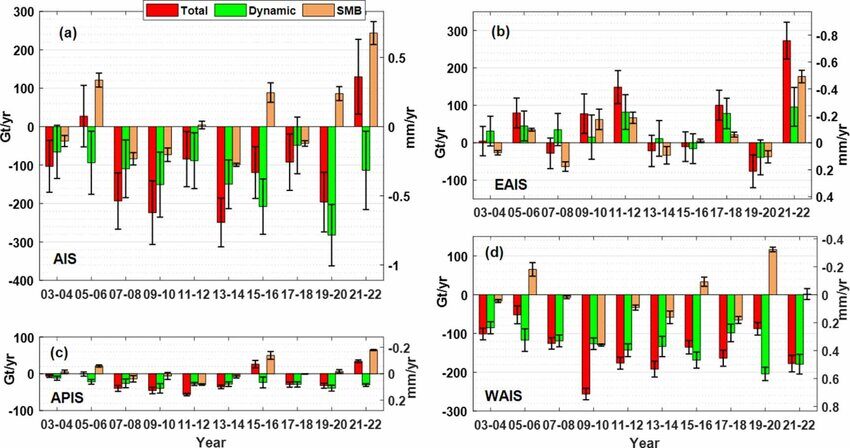Comment: The information below is the abstract from a scientific paper published November 4th 2023 that has yet to receive much, if any, mainstream coverage - unsurprisingly - however the conclusion of their findings are stated fairly clearly.
Abstract and Figures
The Antarctic Ice Sheet (AIS) is susceptible to global climate change, and its mass loss has been 92 ± 18 Gt/yr between 1992 and 2020. Given the current intensive global warming, we investigate the AIS mass changes from January 2003 to December 2022, using the newly released satellite gravimetry and atmospheric datasets.
The results show that the continuous mass loss in the AIS between 2003 and 2020 was 141.8 ± 55.6 Gt/yr. However, the AIS showed a record-breaking mass gain of 129.7 ± 69.6 Gt/yr between 2021 and 2022. During this period, the mass gain over the East AIS and Antarctic Peninsula was unprecedented within the past two decades, and it outpaced the mass loss in the Amundsen sector of the West AIS from 2003 to 2022. Basin-scale analysis shows that the mass gain mainly occurred over Wilhelm II Land, Queen Mary Land, Wilkes Land, and the Antarctic Peninsula due to anomalously enhanced precipitation.
Further investigation reveals that during 2021-2022, a pair of symmetrically distributed high-low pressure systems, located at approximately 120°W and 60°E in the Southern Ocean, drove the observed abnormal precipitation and mass accumulation.
Wei Wang, Yunzhong Shen, Qiujie Chen and Fengwei Wang
College of Surveying and Geo-informatics, Tongji University, Shanghai, People's Republic of China State Key Laboratory of Marine Geology, Tongji University, Shanghai, People's Republic of China




Comment: This seems to be further evidence showing that the apparent brief period of warming that our planet underwent in recent decades is fast being replaced with significant global cooling.
It also seems to support research showing that, whilst increased undersea volcanic and geothermal activity has led to a reduction of ice in some regions, it's being countered by the increasingly extreme cold temperatures from above:
- Little Ice Age triggered by unusually warm period, unprecedented cold struck within 20 years
- Leading Russian polar scientist: Cooling begins in 2030...Climate crisis a 'Globalist Scam'
- Scientists observe ice thickening above 'inactive' volcano in Antarctica
And check out SOTT radio's: